
56 VOLT LITHIUM-ION REAR MOTOR BIKE-HANDLE BRUSH CUTTER — BCX3800 56 VOLT LITHIUM-ION REAR MOTOR BIKE-HANDLE BRUSH CUTTER — BCX38008 9
CE
This product is in accor-
dance with applicable EC
directives.
WEEE
Waste electrical products
should not be disposed of
with household waste. Take
to an authorized recycler.
Noise
Guaranteed sound power
level. Noise emission to the
environment according to
the European community’s
Directive.
V Volt Voltage
Direct
Current
Type or a characteristic of
current
n
0
No Load
Speed
Rotational speed, at no load
min
-1
Per Minute Revolutions per minute
GENERAL POWER TOOL SAFETY WARNINGS
WARNING: Read all safety warnings,
instructions, illustrations and specications
provided with this power tool. Failure to follow all
instructions listed below may result in electric shock, re
and/or serious injury.
Save all warnings and instructions for future
reference.
The term “power tool” in the warnings refers to your
mains-operated (corded) power tool or battery-operated
(cordless) power tool.
WORK AREA SAFETY
◾ Keep work area clean and well lit. Cluttered or dark
areas invite accidents.
◾ Do not operate power tools in explosive
atmospheres, such as in the presence of
ammable liquids, gases or dust. Power tools create
sparks which may ignite the dust or fumes.
◾ Keep children and bystanders away while
operating a power tool. Distractions can cause you
to lose control.
ELECTRICAL SAFETY
◾ Power tool plugs must match the outlet. Never
modify the plug in any way. Do not use any adaptor
plugs with earthed (grounded) power tools.
Unmodied plugs and matching outlets will reduce risk
of electric shock.
◾ Avoid body contact with earthed or grounded
surfaces, such as pipes, radiators, ranges and
refrigerators. There is an increased risk of electric
shock if your body is earthed or grounded.
◾ Do not expose power tools to rain or wet
conditions. Water entering a power tool will increase
the risk of electric shock.
◾ Do not abuse the cord. Never use the cord for
carrying, pulling or unplugging the power tool.
Keep cord away from heat, oil, sharp edges or
moving parts. Damaged or entangled cords increase
the risk of electric shock.
◾ When operating a power tool outdoors, use an
extension cord suitable for outdoor use. Use of
a cord suitable for outdoor use reduces the risk of
electric shock.
◾ If operating a power tool in a damp location is
unavoidable, use a residual current device (RCD)
protected supply. Use of an RCD reduces the risk of
electric shock.
PERSONAL SAFETY
◾ Stay alert, watch what you are doing and use
common sense when operating a power tool. Do
not use a power tool while you are tired or under
the inuence of drugs, alcohol medication. A
moment of inattention while operating power tools
may result in serious personal injury.
◾ Use personal protective equipment. Always wear
eye protection. Protective equipment such as a dust
mask, non-skid safety shoes, hard hat, or hearing
protection used for appropriate conditions will reduce
personal injuries.
◾ Prevent unintentional starting. Ensure the switch
is in the off-position before connecting to power
source and/or battery pack, picking up or carrying
the tool. Carrying power tools with your nger on the
switch or energizing power tools that have the switch
on invites accidents.
◾ Remove any adjusting key or wrench before
turning the power tool on. A wrench or a key left
attached to a rotating part of the power tool may result
in personal injury.
◾ Do not overreach. Keep proper footing and balance
at all times. This enables better control of the power
tool in unexpected situations.
◾ Dress properly. Do not wear loose clothing or
jewelry. Keep your hair, clothing and gloves away
from moving parts. Loose clothes, jewelry or long hair
can be caught in moving parts.
◾ If devices are provided for the connection of dust
extraction and collection facilities, ensure these
are connected and properly used. Use of dust
devices can reduce dust-related hazards.
◾ Recommendation that the tool always be supplied
via a residual current device having a rated
residual current of 30 mA or less.
◾ Do not let familiarity gained from frequent use of
tools allow you to become complacent and ignore
tool safety principles. A careless action can cause
severe injury within a fraction of a second.
POWER TOOL USE AND CARE
◾ Do not force the power tool. Use the correct power
tool for your application. The correct power tool will
do the job better and safer at the rate for which it was
designed.
◾ Do not use the power tool if the switch does not turn
it on and off. Any power tool that cannot be controlled
with the switch is dangerous and must be repaired.
◾ Disconnect the plug from the power source and/
or remove the battery pack, if detachable, from
the power tool before making any adjustments,
changing accessories, or storing power tools. Such
preventive safety measures reduce the risk of starting
the power tool accidentally.
◾ Store idle power tools out of the reach of children
and do not allow persons unfamiliar with the
power tool or these instructions to operate the
power tool. Power tools are dangerous in the hands of
untrained users.
◾ Maintain power tools and accessories. Check for
misalignment or binding of moving parts, breakage
of parts and any other condition that may affect
the power tool’s operation. If damaged, have the
power tool repaired before use. Many accidents are
caused by poorly maintained power tools.
◾ Keep cutting tools sharp and clean. Properly
maintained cutting tools with sharp cutting edges are
less likely to bind and are easier to control.
◾ Use the power tool, accessories and tool bits etc.
in accordance with these instructions, taking into
account the working conditions and the work to
be performed. Use of the power tool for operations
different from those intended could result in a
hazardous situation.
◾ Keep handles and grasping surface dry, clean
and free from oil and grease. Slippery handles and
grasping surfaces do not allow for safe handling and
control of the tool in unexpected situations.
BATTERY TOOL USE AND CARE
◾ Recharge only with the charger specied by the
manufacturer. A charger that is suitable for one type
of battery pack may create a risk of re when used
with another battery pack.
◾ Use power tools only with specically designated
battery packs. Use of any other battery packs may
create a risk of injury and re.
◾ When battery pack is not in use, keep it away from
other metal objects, like paper clips, coins, keys,
nails, screws or other small metal objects, that can
make a connection from one terminal to another.
Shorting the battery terminals together may cause
burns or a re.
◾ Under abusive conditions, liquid may be ejected
from the battery; avoid contact. If contact
accidentally occurs, ush with water. If liquid
contacts eyes, additionally seek medical help.
Liquid ejected from the battery may cause irritation
or burns.
◾ Do not use a battery pack or tool that is damaged
or modied. Damaged or modied batteries may
exhibit unpredictable behaviour resulting in re,
explosion or risk of injury.
◾ Do not expose a battery pack or tool to re
or excessive temperature. Exposure to re or
temperature above 100 °C may cause explosion.
◾ Follow all charging instructions and do not charge
the battery pack or tool outside the temperature
range specied in the instructions. Charging
improperly or at temperatures outside the specied
range may damage the battery and increase the risk
of re.
SERVICE
◾ Have your power tool serviced by a qualied repair
person using only identical replacement parts.
This will ensure that the safety of the power tool is
maintained.
◾ Never service damaged battery packs. Service
of battery packs should only be performed by the
manufacturer or authorized service providers.
TRAINING
◾ Read the instructions carefully. Be familiar with the
controls and the proper use of the machine.
◾ Never allow people unfamiliar with these instructions
or children to use the machine. Local regulations can
restrict the age of the operator.
◾ Keep in mind that the operator or user is responsible
for accidents or hazards occurring to other people or
their property.

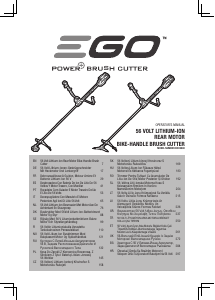


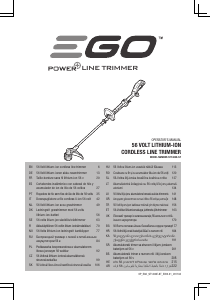
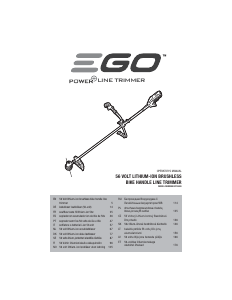
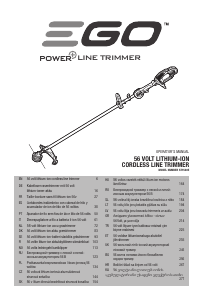
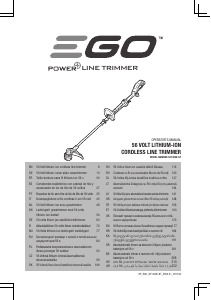
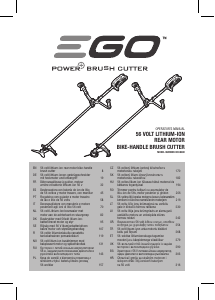
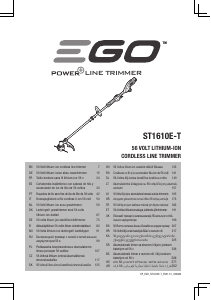
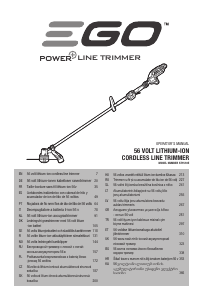
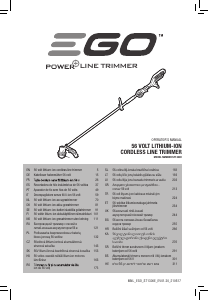
Participe da conversa sobre este produto
Aqui você pode compartilhar o que pensa sobre EGO BCX3800 Aparador de relva. Se você tiver alguma dúvida, primeiro leia atentamente o manual. A solicitação de manual pode ser feita através do nosso formulário de contato.